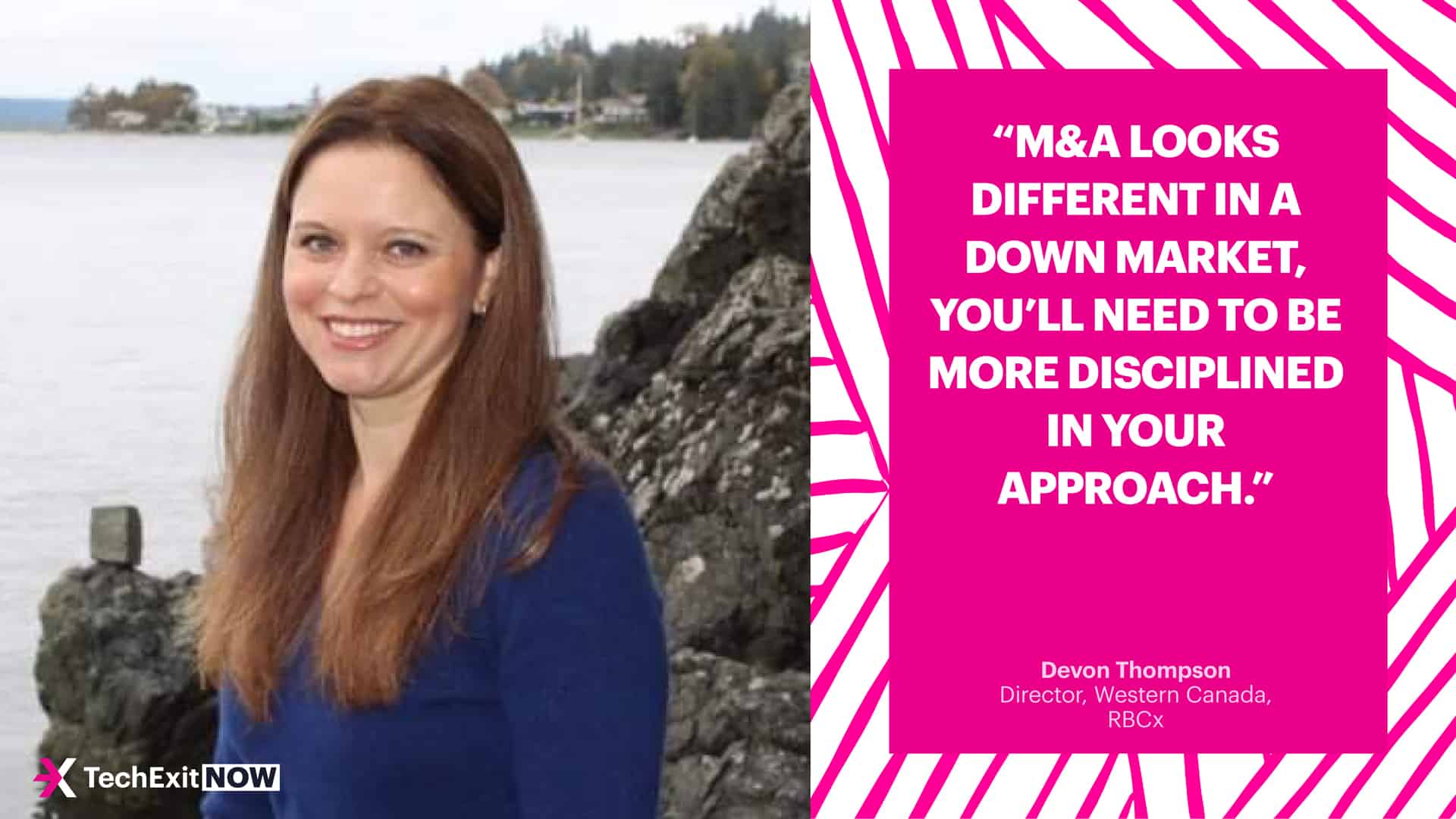The 3 Questions Every Founder Should Ask Before Pursuing Growth Via M&A in a Downturn
TechExit

Let’s agree that economic conditions are shifting. Our ecosystem is facing new potential headwinds while at the same time uncovering upside opportunities as we hunker down into this bear market. If you’re still considering getting into the ring of M&A right now, then you’re not alone. There are certainly interesting opportunities out there that have likely experienced a dip in deal premiums if the acquirer is prepared, strategic, and can stomach the risk. Speaking with TechExit, Devon Thompson, the Director for Western Canada at RBCx, shared the three questions every founder should ask before pursuing growth via M&A in a downturn.
Key takeaways:
- Founders (and their boards) need to clarify their priorities.
- Hunker down for the possibility of a prolonged downturn.
- Re-assess the opportunities for synergies.
Startup M&A activity moves in cycles. The uncertainty in our macro environment today has already impacted M&A in the tech space. While M&A activity is likely to be a significant driver of value for tech firms in 2022, and deal volumes are expected to maintain a strong pace, we are feeling the impacts of rising interest rates and inflation with the possibility of a recession in the near-term.
Speaking with TechExit.io, Devon Thompson, the Director for Western Canada at RBCx, shares her thoughts on how she advises startups during these market swings. Devon shared the three questions every founder should ask themselves before pursuing growth via M&A in a downturn.
1. What are our clarified priorities and are we aligned with our partners?
This is the moment of truth. How a founder (and their board) dig deep during these market shifts will determine the trajectory of the company in both the short and long term. The leadership team needs to understand that what made them successful in a bull market, will not necessarily make them successful in a bear market.
Navigating these uncertain times requires a different mindset and, in most cases, a different strategy. Leadership teams need to be laser focused on their core business and measuring the right KPIs on a consistent basis to ensure they can make informed decisions as conditions shift. It’s important to determine how these shifts in the market are affecting your potential target company. Are they adjusting their strategy? Are they more or less vulnerable? Devon said that valuations are coming back to a “more appropriate” level from the fevered highs of the past few years which will entice well-positioned buyers to the table. However, it could also make sellers hesitant since they might feel they aren’t getting a fair valuation because of temporary market conditions.
Finally, leaders will need to take decisive action to course correct or to re-confirm their existing priorities and strategies. Time should be spent with investors, board members, stakeholders, as well as employees gathering feedback and then communicating shifts in strategy, areas to capitalize on, and making sure these partners are aligned.
A good partner will be able to advise you through this process and help you think about strategic priorities and making it through this cycle still in growth mode.
“M&A looks different in a down market,” said Devon. “You’ll need to be more disciplined in your approach.”
2. Is your house in order?
“It’s imperative that once priorities and strategies are clarified, that founders understand their existing cash runway, burn, unit economics and, thus, capital efficiency,” said Devon. It’s difficult to predict how long or how deep this dip will be; however, managing costs is paramount in a down market. We are no longer in a system that is demanding growth at all costs. The board room conversations are now centered on efficiencies, paths to profitability, and ensuring the company is strategically positioned to navigate this market shift.
For well-positioned buyers, they will be looking at these same metrics much more closely for potential targets as they adjust their M&A strategy in this market. Inorganic growth should be intentional no matter where we are in a market cycle: geographic expansion, talent acquisition, IP growth, or simply doubling down in a region by merging with a competitor
If taking on equity: Raising a fresh round of capital can be especially difficult in a down market. How much dilution are you willing to accept to pursue M&A?
“Private market valuations follow the public markets so we can already see that valuations have dipped across all tech sub sectors. We encourage founders to speak with their existing investors to discuss options,” said Devon.
If taking on debt: How much debt can your growth and cash reserves support and if you’ve recently raised a fresh equity round, have you considered venture debt to support your M&A strategy?
It’s essential that your potential capital partners understand how you’re going to be using the funds so they can tailor a facility to the company’s needs.
3. Have the opportunities for synergies shifted and how?
Macro dynamics continue to drive uncertainty as founders re-assess their M&A strategies in this market: from geopolitical tensions to uninspiring IPO debuts to supply chain disruptions.
However, on the flip side, we can see that Canada’s strong foundation in tech continues to shine. 2021 was a banner year for Canadian companies raising venture capital as they landed over $14.7 billion and the CVCA has published Q1 data for 2022 at $4.5 billion raised.
“For well-capitalized, disciplined companies with, or on the path to, strong unit economics, I think we’ll continue to see them invest in M&A even in this uncertain market,” said Devon. However, they are likely re-assessing how the potential synergies will shake out in this environment: is the target company strategically lean on the talent side, how are interest rates compressing the target’s multiples, and are supply chain concerns slowing growth opportunities to name a few?”.
BACK











